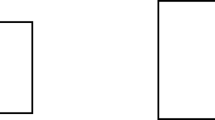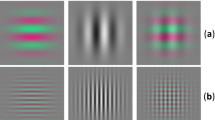Summary
-
1)
Starting from the far reaching agreement accomplished during the last years with regard to the essence of so called colour transformation the attempt has been made to specialize the accepted general principle according to which colour-matter and -mode of appearance are both functions of the organization of the visual field.
-
2)
Two effects are distinguished from each other: (a) difference increase (in many cases identical with traditional contrast phenomena) and (b) shift of level (more or less what has been called transformation). Then the concept of the neutral level is introduced and the proposition formulated that the general colour level of the field of visi onapproximates the neutral as closely as possible.
-
3)
The relation of the principles of the shift of level and the neutral level to certain theories advanced by Jaensch and his school is discussed.
-
4)
In support of these principles a new experiment with coloured shadows is reported.
-
5)
Certain of Kroh's results are discussed from the point of view of our two principles.
-
6)
Some experiments are described which make it appear highly improbable that all so called contrast phenomena can be reduced to effects of shift of level.
-
7)
A theory of the perception of illumination compatible with our principles is sketched.
-
8)
It is briefly explained when and why an (approximate) constancy follows from our principles.
Zusammenfassung
-
1)
Ausgehend von der weitgehenden Übereinstimmung, die in den letzten Jahren über das Wesen der sogenannten Farbentransformation erreicht worden ist, wird der Versuch gemacht, das allgemein anerkannte Prinzip, nämlich daß die gesehene Farbe in Materie und Erscheinungsweise eine Funktion der gesamten Gesichtsfeldorganisation ist, näher zu spezialisieren.
-
2)
Es werden zunächst zwei Effekte unterschieden, a) Unterschiedsvergrößerung (in vielen Fällen mit üblichen Kontrasteffekten identisch) und b) Niveauverschiebung (im großen und ganzen das, was man Transformation genannt hat). Es wird dann der Begriff des neutralen Niveaus eingeführt und der Satz aufgestellt, daß das Gesamtniveau des Gesichtsfelds sich dem neutralen Niveau so sehr annähert wie möglich.
-
3)
Das Verhältnis der Prinz pien der Niveauverschiebung und des Dranges zum neutralen Niveau zu gewissen von Jaensch und seiner Schule entwickelten Theorien wird diskutiert.
-
4)
Zur Sicherung unserer Prinzipien wird ein neuer Versuch an farbigen Schatten mitgeteilt.
-
5)
Gewisse Ergebnisse von Kroh werden vom Boden der neuen Prinzipien aus diskutiert.
-
6)
Einige Experimente werden beschrieben, die die Zurückführung aller sogenannten Kontrastphänomene auf Niveauverschiebung als höchst unwahrscheinlich erscheinen lassen.
-
7)
Eine mit den obigen Prinzipien verträgliche Theorie der Beleuchtungswahrnehmung wird skizziert.
-
8)
Es wird kurz erläutert, wann und warum aus den Prinzipien (angenäherte) Konstanz folgen muß.
Similar content being viewed by others
Author information
Authors and Affiliations
Rights and permissions
About this article
Cite this article
Koffka, K. Beiträge zur Psychologie der Gestalt. Psychol. Forsch. 16, 329–354 (1932). https://doi.org/10.1007/BF00409735
Received:
Issue Date:
DOI: https://doi.org/10.1007/BF00409735




